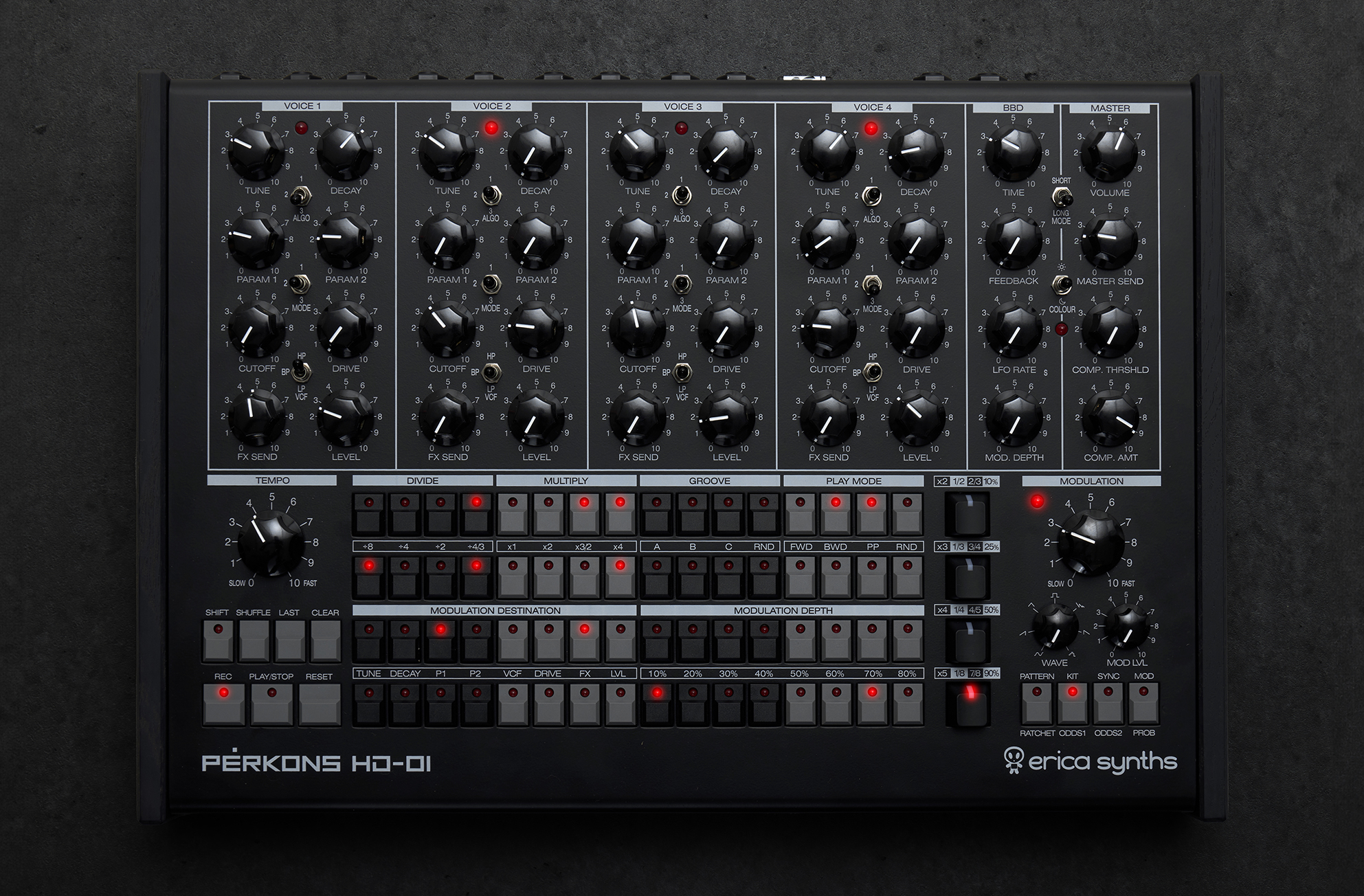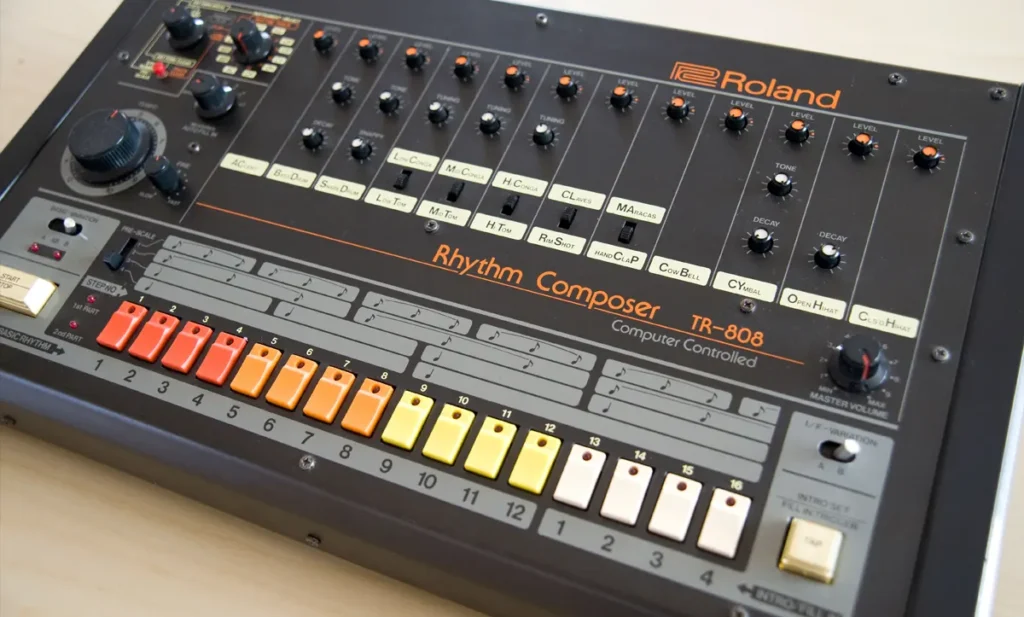Do you want a drum machine to control your DAW, or hardware only one?
As stated previously, there are models of drum machines that do both of these tasks. Some of them only control software inside a computer and some are purely analog. While the analog drum machine may sound better, the digital drum machine will be more versatile and potentially more practical in the long run.
Drum machines range from inexpensive to very pricey
The most affordable digital drum machine, the Maschine Mikro, is one of our favorite recommendations. In fact, you can do more with this piece of gear than most analog hardware options we have on the list. However, if you’ve got some experience under your belt and are looking for something more specialized, you may have to look at the higher price ranges.
If you want to skip the whole buying a physical product route and just go in the box, you can get many different drum machine plugins that emulate real hardware: Audio Damage Tattoo, Elecktroid, Image-line Drumaxx, D16 Nepheton, just to name a few. In fact, most digital audio workstations come bundled with a step-sequencer and drum machine right out the box. Check the manual of your DAW and see what you get with it.
Determine Your Needs
Drum machines are utilized by musicians, producers, drummers, and hobbyists. A musician performing on stage might want to add more sounds to their live set, so they purchase a drum machine to use on stage.
Music producers in the studio working on hip-hop or electronic music may want a drum machine to give their tracks a foundational groove or to get a little inspiration flowing when writing new music.
In this article, we featured both MIDI drum pads as well as drum machines. MIDI drum pads can perform the exact same tasks that a drum machine can do inside of a digital audio workstation.
So not only do you get a drum machine for composing beats and patterns, but you’ll also get a MIDI controller that is useful for creating unique MIDI patterns not reliable on a step sequencer.
Analog or digital? What is better?
If you’re curious about this question, then I’m sure you’ve seen the millions of forum posts online debating this topic back and forth. An analog drum machine is an instrument that creates the sounds using synthesis with its own hardware.
A digital drum machine will usually not contain synthesis hardware, rather, will need to connect to a computer via USB and software inside the computer will create the drum synthesis.
Personally, I tend to gravitate more towards digital, as there are way more options for incredible sounds and much more value for your money. One could say that this is detrimental to being creative, as having too many options on the table can often result in poor choices.
Sure, the sound isn’t as purely organic as the analog signal, but it’s now close enough and I believe that we almost cannot perceive a difference. If we aren’t already there with our technology, I’m sure we will be soon.
How to Use a Drum Machine
Fortunately, most analog drum machines are extremely intuitive. Rhythms are generally built in what is known as a step-sequencer.
This patter-based grid usually features rubber pads that allow you to choose what beats of a 16th note grid are voiced from each instrument.The first time you sit down with a drum machine, I think you’ll be pleasantly surprised.
They’re very fun to play with, even if you have never used one. Just hit buttons and eventually, you will get a feel for how it works.
How to Chose the Perfect Drum Machine for You
Sound quality
Be sure to take time to listen to each one of these products, whether that be on YouTube or physically at a music store. Local retailers won’t always have everything in stock, so online may be the better option for demoing sounds.
Certain drum machines can sound warmer or more digital. These debates about the quality are subjective, so don’t worry yourself too much if you can’t tell a difference.
Your budget
As we have stated previously, there is a large range of prices when looking for drum machines. While expensive isn’t always better, some of the pricey drum machines do offer more features and sounds.
Surprisingly, the Maschine Mikro boasts a lot for such a low cost!
DAW Compatibility
While some people just want a straight-up analog drum machine, others may want to integrate it with their production setup. This can be anything from hardware control of your digital audio workstation, using sounds from a VST plugin, or playing back MIDI through the drum machine and outputting it to a PA system.
There’s no right or wrong here, and some drum machines will offer more compatibility than others.
Portability
Musicians travel a lot. It’s how we make a living. Being able to produce more and more music on the road is a necessity these days and some rhythm machines will be more portable than others. If you travel, it’s better to go with an option that is smaller and thinner.
Do you need additional sounds?
While most digital drum machines come included with sounds, the ability to add and expand your sample library is almost necessary these days!
We recommend using a little bit of both and getting as creative as you can. Splice offers a $7.99/mo membership to millions of sounds and samples uploaded by a community of producers.
I personally use Splice and wish I would have found it sooner.
Usage rights of preset loops, effects, patches
Are there copyright issues when using presets, effects, and patches from virtual drum machine libraries and VST instruments?
Generally, no. When you purchase sample libraries or virtual instruments, even though you yourself didn’t create the samples, the instrument/sample makers usually gives you a license to use the sounds in your own productions with no legal ramifications.
Though I can’t speak on every single library out there, most of them operate this way, else, they wouldn’t be in business.
A brief history of the drum machine
We didn’t always have metronomes and rhythm machines. These robotic instruments haven’t been around that long. The most popular drum machine to date is the Roland TR-808. Here are some of the very early ones:
1959 – Wurlitzer Sideman
The very first electronic drum machine was the 1959 Wurlitzer Sideman. It was designed specifically for accompaniment, allowing piano players and organists to play along with a groove. Unfortunately, we do not have any audio samples of this drum machine.
It operates with a large motor that spins a large circular disc that I believe is playing all the sounds you hear, similar to how a music box works. Depending on how fast the motor spins determines the tempo of the groove (between 34 and 150 beats per minute).
This thing is large. It’s housed in a wooden frame that looks just like an entertainment center from the 1950s. There have been some sales of these drum machines on Reverb.com, but for the most part, they’re extremely rare.
The development of this drum machine raised issues with the musicians’ unions, which believed that the invention of the drum machine would replace the work of real musicians. They ruled that the Sideman could only be used in cocktail lounges if the keyboard player of the evening was paid three times the amount of a normal gig. Production of the Sideman ran for ten years.
1964 – The Rhythm Prince created by Seeburg/Gulbransen
After the success of the Sideman, two manufacturing companies partnered up to create what is known as the Rhythm Prince. This drum machine was much smaller than its predecessor, but it still was around the size of a guitar amp head, even somewhat resembling one.
After experimenting with tactics to reduce the size of the instrument, Seeburg was able to develop a compact electronic rhythm pattern generator using what’s known as a diode matrix.
The Select-A-Rhythm was much smaller and was eventually installed on electronic organs for accompaniment and the drum machine finally began to gain popularity.
1972 – The ComputeRhythm from Eko
Finding one of these retro drum machines is going to cost you, big time. In fact, I found a listing on Reverb.com that was priced at $11,269.88 plus shipping. Now I don’t think the listing sold, but you can see how rare the ComputeRhythm really is.
This drum machine is one of the rarest and most sought-after vintage pieces of gear. Why is this drum machine so valuable? It doesn’t sound that great. It’s a very basic analog rhythm machine by today’s standards.
While it did have a revolutionary six-row matrix for programming beats, fewer than twenty of these units were actually sold. You can imagine how rare it is to find one of these. The ComputeRhythm appeared on records of two iconic electronic musicians: Manual Göttsching and Jean-Michel Jarre.










5 comments
Nunya Bizness
ALL OF THESE UNITS ARE PRE 2023! Why not the Korg Drumlogue? I just got it and it’s amazing. It’s my remix in a box
WM
How do you give advice to people if you do not even have an understanding of the most basic concepts of music production? Digital signals DO NOT have jagged edges. Perfectly smooth sine waves can be recreated by just defining two points of a half cycle of a wave. Look up the Nyquist-Shannon sampling theorem.
Frank J. Toews
I am a one-man show, wishing to add a simple-to-use drum machine to my instrument’s performance. I want to keep it simple. I do mostly ‘oldies’, ‘country classics’, and some ‘gospel’. I don’t need a large number of different beats. A plus would be if another instrument (2nd one) could plug in and, if a microphone could also be plugged in. Is there such a thing as a permanent rechargeable battery machine? That would be useful. What machine would you recommend that would have most/all of these features, and that would be economical, say around $150.00 (Canadian)?
Max
The picture with the difference between analogue and digital is simply wrong.
Barry C Collins
Actually I’d say go with the beat buddy pedal size drum machine. As a solo artist I can tell you it’s unreal and sounds so realistic not to mention easy to use. Why it’s not listed blows my mind??? Ignore all these and buy the beat buddy as it’s by far a better drum machine & you can figure it out quickly. Lastly, it has a downloadable library of Soo many real songs you can add as it’s a pedal that can be upgraded for free. So if you want the best live application it’s the best buddy !! Not any of this stuff( DON’T WASTE YOUR $)